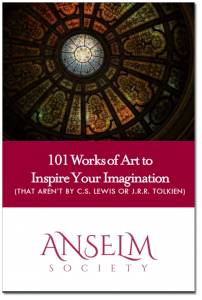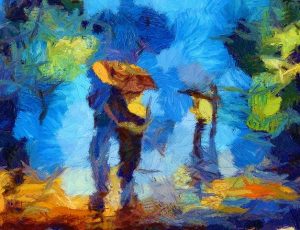EPISODE SUMMARY:
In season 4 episode 11 of the Eudo Podcast, we are going to talk once again about art and beauty (if you are interested in this topic, we invite you to listen to season 3 of the Eudo podcast). In this episode, we’ll narrow our focus and explore one theoretical and one practical topic related to art and beauty and creativity: first, how does a sacramental view of the universe shape our understanding of art and beauty and second, how practically, can each of us be makings of art and beauty as we find our place in the divine drama.
EPISODE NOTES:
How Does The Fact That We Live In A Sacramental Universe Shape Our Understanding Of Art, Beauty, Creativity, And The Divine Drama?
Jamie K. A. Smith argues that a Sacramental view of the arts and creativity is grounded in key theological truths [1].
- First, the affirmation of the goodness of creation. The fact that all God has made is good is a strong affirmation that our embodiment and finitude are not lacks or deficiencies but gifts, aspects of our creature-hood that ought to be celebrated. Thus, our materiality is not part of our fallenness, but part of what it means to be fully human; our souls are not seeking escape from the body, but are in their proper place as embodied souls.
- Second, the re-affirmation of materiality and embodiment in the incarnation. In the incarnation, according to Smith, the transcendent inhabits the immanent without loss. In taking on a human nature and body, the Eternal Son remains fully the Eternal Son, yet inhabits the physical universe as fully man too.
- Third, this consistent valuation of the materiality and embodiment of creatures is re-affirmed again given the future resurrection, where our souls are re-united with our bodies for eternity.
Implications for art and creativity of these three dogmatic truths regarding creation, incarnation, and resurrection
According to Smith, “The consistent and persistent affirmation of the material acts as a counter-weight to the “docetic tendencies of Christian thought” [2]. If being embodied (and thus being sensible and sensuous) are constitutive of what it means to be creatures, then we find a theological basis for the arts, drama, music, poetry, and so on. As Smith writes, “Art, as an affective medium of images that moves and stirs the passions, can function in such a way as to move the soul toward God to find its ultimate enjoyment” [3].
Thus, a Christian incarnation ontology rejects the devaluation of images in at least two ways:
- First, “the sensible world is to function as a sacrament or image that points us to God” [4].
- Second, “given the embodied structure of the human person, images (and the imagination) play an essential role in human knowing and thus contribute to knowledge rather than deceive us” [5].
The point is that art is not just an afterthought—in life, evangelism, apologetics, and discipleship, but an integral part of how we grow in Christ and show others the brilliance and beauty of Jesus and the gospel.
How can each of us, whether we are professional artist or just regular human beings moved by art, incorporate creativity and beauty into our lives?
Six principles of the writing life, or more broadly, the artistic life, as discussed by Andrew Peterson in his excellent book Adorning the Dark [6].
- First, Serving the Work. This principle points to the mysterious nature of the creative act. The idea here is that we respect to the form of art. We strike that balance between art and agenda. But we serve the work by respecting the creative process and inviting God into it.
- Second, Serving the Audience. The idea here is to always remember to love the listener. Don’t geek out in the language you use, but speak to your audience in a way they can understand. Treat your art—a sermon, painting, book, song—as in invitation to a dinner party in which you make the guest feel at ease. In this way, we serve—and love-our audience.
- Third, Selectivity. You don’t need to say, or include everything, when you write or create. So, work relentlessly to get rid of the nonnecessary, the superfluous, that part of your sermon or essay that no one would miss!
- Fourth, Discipline. Creating new things is difficult. It requires work. It requires discipline and focus and sacrifice. Being disciplined is a kind of dying to self—a dying to your wants, even your fears, and stepping out in faith.
- Fifth, Discernment. Peterson says, “if you want to become an artist, you have to cultivate artistic discernment” [7]. Discernment “demands more from a film or song than mere entertainment, [it] asks questions about content and intent” [8]. So, become a student of your craft. If we want our work to survive us, we must submit to a lifelong apprenticeship of our craft.
- Finally, Community. Art nourishes community and community nourishes art. First, art nourishes community: when we dream together, and create together, our hearts are knitted together and magical things take place. Second, community nourishes art.
Here is a link to the blog we mentioned from the Rabbit Room on “Concerning Beauty.”
CONCLUDING REMARKS:
Two final thoughts:
First, a helpful set of criteria for good Christian art. According to Peterson, good Christian art possess three qualities: honesty, truth, and beauty [9]. If you remove any one of these, the created thing suffers. Remove truth and an honest and beautiful song becomes like much of the excellent mainstream work out there—it moves us, but we are not drawn to the truth of God or the gospel in this movement of the heart.
Finally, a practical suggestion for how to see and delight in the world as Jesus does. The idea, according to Peterson, is to find your focal practice. A focal practice is defined as having three parts: “(1) It demands discipline and hard work; (2) it connects us with others (and our own hearts); and (3) it puts us in touch with realities greater than ourselves” [10].
RESOURCES MENTIONED:
- McDermott, Gerald R. Everyday Glory: The Revelation of God in All of Reality. Grand Rapids, MI: Baker, 2018.
- Peterson, Andrew. Adorning the Dark. Nashville, TN: B&H, 2019.
- Smith, James K. A. “Participation and Incarnation,” in Introducing Radical Orthodoxy: Mapping a Post-Secular Theology. Grand Rapids, MI: Baker, 2004.
For a the free e-book from our season 4 sponsor, click this link: “101 Works of Art to Inspire Your Imagination (That Aren’t by C. S. Lewis or J. R. R. Tolkien)”


[1] James K. A. Smith, “Participation and Incarnation,” in Introducing Radical Orthodoxy: Mapping a Post-Secular Theology (Grand Rapids, MI: Baker, 2004), 224–229
[2] Ibid., 227.
[3] Ibid., 228.
[4] Ibid.
[5] Ibid., 229.
[6] Andrew Peterson, Adorning the Dark (Nashville, TN: B&H, 2019).
[7] Ibid., 134.
[8] Ibid., 135.
[9] Ibid., 188–189.
[10] Ibid., 191.





